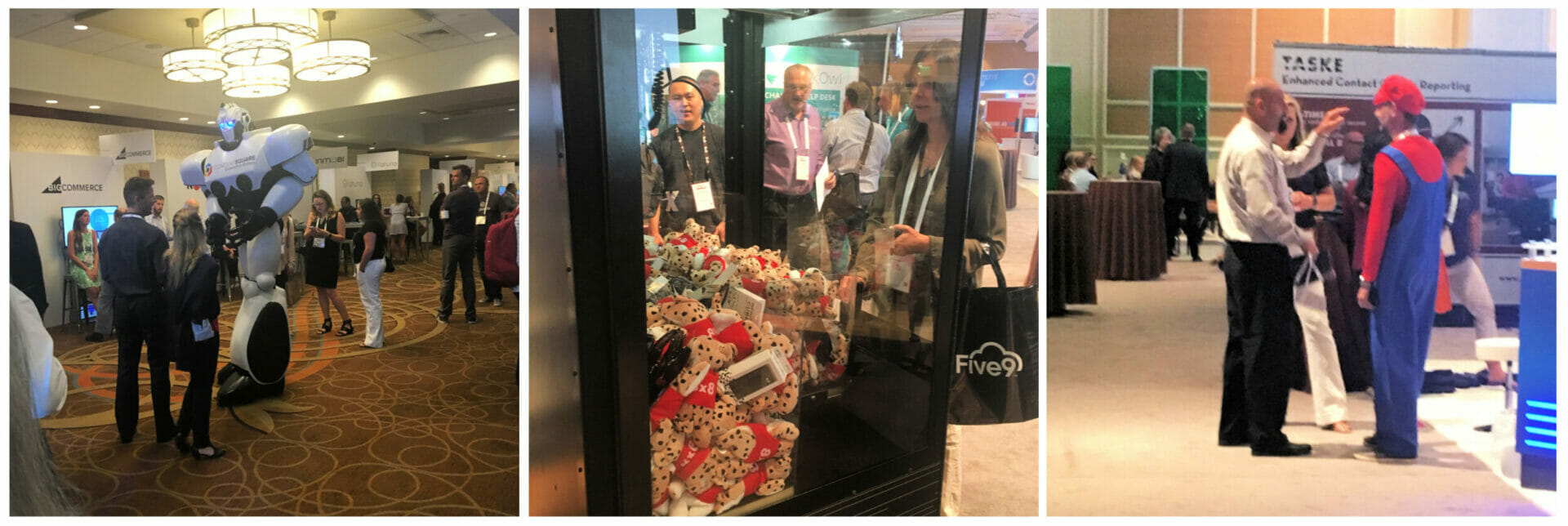If you’ve been to a conference lately, you may have noticed a trend: over-the-top vendor booths.
I spoke at an event in Vegas recently and was surprised how much of a circus the exhibit hall had become – literally. In addition to t-shirts and swag there were Plinko games, facials, chair massages, free ice cream and cotton candy, roaming cartoon characters (remember Super Mario?), yellow tutus, and a claw machine. The craziness isn’t unique to that event (or to Vegas). I encountered a giant robot in Boston and stilt-walkers and acrobats in San Francisco in the past few years.
Gimmicks like these may draw traffic, but do they produce quality B2B leads? I doubt it. Read on to learn why I’m skeptical, and how one company bucked the trend with a focus on meaning over mayhem.
Three examples of what companies do to stand out in a vendor showcase. (Photos: M. Burns)
As an analyst, I’ve been briefed by hundreds of vendors. Even in a quiet room, focused on one firm it’s hard to tell what they do or how they differ from others with a “customer experience management platform.” The features may be radically different, but everyone uses the same marketing mumbo-jumbo. It was my job to figure out the difference, in part because it’s such a hard thing to do.
At a conference, you’re trying to have that conversation with someone who isn’t required to care and probably can’t hear over the chaos around them. If a prospect is introverted like me, they may choose not to engage in that setting – they’re already on sensory overload. Those who do approach will remember a fraction of the experience. What do you want that to be, your product or a promotional stunt? I doubt anyone wants to end up like a failed Superbowl commercial – everyone talks about it, but no one can remember what company it was for.
There is another way to approach events—be a port in the storm. That’s what UX research firm AnswerLab did at Forrester’s CXNYC event this past June, and I’m still talking about it. I’m not affiliated with AnswerLab in any way, and this is not a sponsored post, I was just impressed by the experience they delivered. Here’s what happened.
I was drawn to the AnswerLab booth by an old-fashioned bike like the one my grandmother used to ride. It seemed out of place amid the screens and talk of AI, and the human brain is wired to notice anomalies. The bike had beautiful flowers in the basket, and as I stepped closer to see if they were real someone asked if I wanted a chance to send similar flowers to someone I care about. “Wow, a prize I’d actually want to win,” I thought. As I reached for a business card to put in their raffle bowl, the woman stopped me. That wasn’t how this giveaway worked. Instead of putting something in the glass bowl, I had to take something out of it – one of the small envelopes. If the paper inside said “winner,” the flowers were mine. That’s what happened, and I was thrilled.
My delight turned into hesitation for a moment. It hadn’t occurred to me that I’d have to provide the recipient’s address (in this case my mom) to claim the prize. Clearly, however, my host had anticipated this reaction. She explained — before I even asked — that they wouldn’t use the data for anything other than delivery. I believed her and took the plunge.
Two days later, my mom called in utter shock to say thank you for the flowers. She sent a picture, and I’ll be honest – the bouquet was bigger and nicer than I’d expected.
A week later I got an email from AnswerLab with the subject “How did the flowers work out?” It was a marketing email, of course. The body had info about their research and design services, but they didn’t start talking about the company until they’d asked about my needs and expectations.
As small as this tweak might seem, it evoked a different emotion than the traditional follow-up email. Instead of marketing (how do we get you to buy our stuff?), I was having an empathy-based conversation (if we show that we care about you, you’ll want to know about and possibly work with us).
This experience stands out for several reasons. Not only was it different, it was:
-
Easy. I used an iPad to submit my “order.” No need to find a pen, schlep anything around, or fit a box into my suitcase on the trip home.
-
Meaningful. Giving can feel as good as getting. AnswerLab gave me the thrill of winning plus the joy of knowing I made my mom’s day with an unexpected gift.
-
Extended. By the time the flowers got to my mom’s house that Friday, I’d forgotten about them. Her call was as much a surprise for me as the flowers were for her. AnswerLab may not have planned it this way, but they ended up giving me two moments of surprise and delight for the price one. The final email was icing on the cake.
I don’t know how much this promotion cost AnswerLab, but you don’t have to spend a ton of money to show customer empathy. I got letters from two life insurance firms on the same day, one of which was all business: “Our records show that you are the beneficiary of policy 12345….” The other started with the line “We were recently notified of the passing of <name> and are very sorry for your loss.” They contained the same information. I’m guessing the cost to print one was nearly the same as the other. Even so, they sent very different messages. Only one made me feel like real people had considered how I’d be feeling as I started the journey of resolving an estate. (That process is its own special hell – more on that in a future post).
Whether it’s a trade show, 1:1 meeting, phone call, chat, email, direct mail, or a letter, no experience happens in a vacuum. There’s a physical, mental, and emotional context that shapes the client’s experience whether you plan for it or not.
I’m off to another conference this week and expect I’ll see more tomfoolery. Hopefully, though, this post inspires at least one marketing team to think differently as they plan for 2020.
In a world that feels louder and more daunting by the day, less may end up being much, much more.




